
Iridaceae is a family of plants in order Asparagales, taking its name from the irises, meaning rainbow, referring to its many colours. There are 66 accepted genera with a total of c. 2244 species worldwide. It includes a number of other well known cultivated plants, such as freesias, gladioli and crocuses.
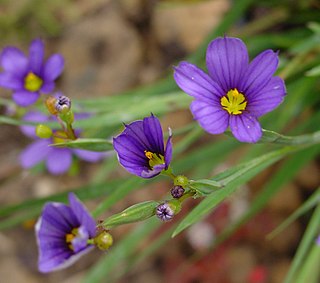
Sisyrinchium is a large genus of annual to perennial flowering plant in the family Iridaceae. Native to the New World, the species are known as blue-eyed grasses and, though not true grasses and in varieties with flower colors other than blue, are monocots.
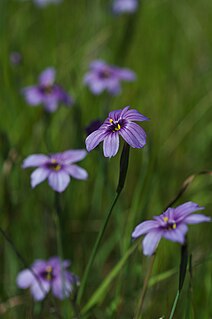
Sisyrinchium bellum, the western blue-eyed grass or Californian blue-eyed grass, is the common blue-eyed grass of California and Oregon in and west of the Sierra Nevada, its range extending south into Baja California. In parts of its range, western blue-eyed grass has previously been classified as Sisyrinchium eastwoodiae, S. greenei and S. hesperium, but these names are now considered synonyms.

Olsynium douglasii is a species of flowering plant in the iris family (Iridaceae). Common names include Douglas' olsynium, Douglas' grasswidow, grass-widow, blue-eyed grass, purple-eyed-grass, and satin flower, It is native to western North America, from southern British Columbia south to northern California, and east to northwest Utah. It is the only species in the genus Olsynium in North America, the remaining 11 species being from South America. It was formerly treated in the related genus Sisyrinchium.

Moraea, the Cape tulips, is a genus of plants in the family Iridaceae, first described as a genus in 1758. The group is widespread across Africa, the Mediterranean, and central and southwestern Asia. The genus name is a tribute to the English botanist Robert More.

Sisyrinchium montanum, the blue-eyed-grass, American blue-eyed-grass, or strict blue-eyed grass, is a grass-like species of plant from the genus Sisyrinchium, native to northern North America from Newfoundland west to easternmost Alaska, and south to Pennsylvania in the east, and to New Mexico in the Rocky Mountains. It has also been introduced to parts of France, likely during the First World War.
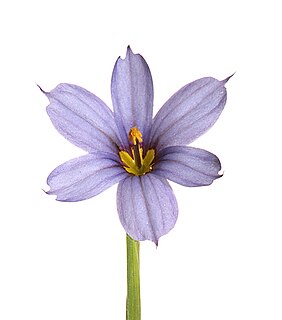
Sisyrinchium angustifolium, commonly known as narrow-leaf blue-eyed-grass, is a herbaceous perennial growing from rhizomes, native to moist meadow and open woodland. It is the most common blue-eyed grass of the eastern United States, and is also cultivated as an ornamental.

Sisyrinchium idahoense, the Idaho blue-eyed grass, is a perennial that is native to western North America. It is not a true grass, but is instead in the family Iridaceae.

Moraea viscaria is the type species of the genus of Moraea in the family Iridaceae that is named after the sticky secretion on the stem and branches.

Sisyrinchium californicum is a species of flowering plant in the iris family known by the common names golden blue-eyed grass, yellow-eyed-grass, and golden-eyed-grass. It is native to the west coast of North America from British Columbia to central California, where it grows in moist habitat, often in coastal areas.
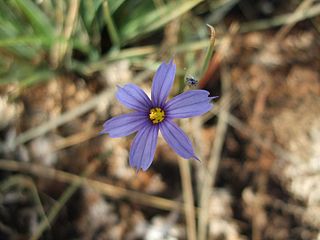
Sisyrinchium funereum is an uncommon species of flowering plant in the family Iridaceae known by the common names Funeral Mountain blue-eyed grass and Death Valley blue-eyed-grass. It is endemic to the Mojave Desert of the United States, where it is known only from the Funeral Mountains and Death Valley area in eastern California, and the Ash Meadows area just over the border in Nevada. It grows in wet, highly alkaline habitat, such as seeps and mineral springs.
Sisyrinchium halophilum is a species of flowering plant in the family Iridaceae known by the common name Nevada blue-eyed grass. It is native to the western United States in and around the Great Basin and Mojave Desert, where it grows in moist, often highly alkaline habitat, such as seeps, meadows, and mineral springs.

Moraea aristata is a species of flowering plant in the family Iridaceae. It is referred to by the common names blue-eyed uintjie or Blouooguintjie in Afrikaans and is a critically endangered species of plant in the genus Moraea, that is endemic to the city of Cape Town and is now restricted to the grounds of the Observatory in the Cape Town suburb of Observatory.
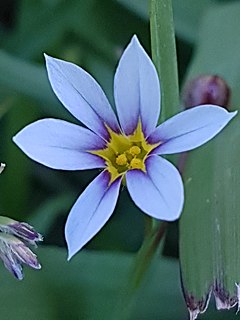
Sisyrinchium micranthum, commonly known as blue pigroot or striped rush-leaf, is a grass-like species in the iris family, Iridaceae. It is native to Mexico, Central America, and South America and widely naturalised elsewhere. The white to cream flowers are between 10 and 20 mm in diameter and have blue to purple centres. These are followed by rounded 3 to 8 mm brown capsules that enclose the dark brown seeds.
Sisyrinchium sarmentosum is a species of flowering plant in the iris family known by the common names mountain blue-eyed grass and pale blue-eyed-grass. It is native to the Pacific Northwest of North America, where it is known from a part of the Cascade Mountains in Washington and Oregon.

Diplarrena moraea, commonly known as white iris, is a member of the iris family, Iridaceae. It occurs in Australian heathland and forest in New South Wales, Victoria and Tasmania.

Sisyrinchium bermudiana, known as Bermudiana or, along with other members of the genus, as blue-eyed-grass, is a flower of the genus Sisyrinchium that is indigenous to the Atlantic archipelago, and British Overseas Territory, of Bermuda. The plant appears and blooms in the spring. It has been used as a totemic flower by Bermudians, and appears in art, jewellery, banknotes and elsewhere. Long believed to be limited to Bermuda, the plant has also been found around Lough Erne and Lough Melvin in County Fermanagh, Northern Ireland, where it is known as feilistrín gorm, or blue-eyed grass.

Sisyrinchium albidum, commonly known as white blue-eyed grass, is a species of flowering plant in the family Iridaceae.














